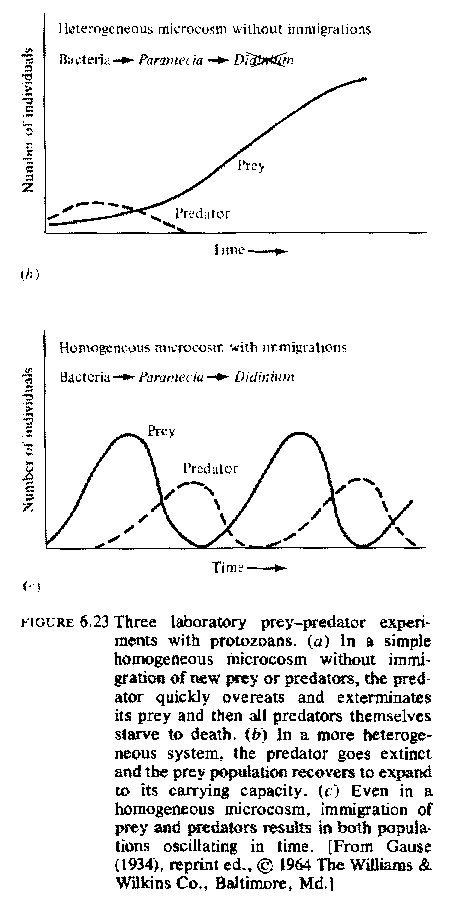Predation Studies
(Taken from Evolutionary Ecology by Eric R. Pianka. Harper & Row 1983.)
Predation is readily studied in the laboratory... Gause, 1934, studied a simple prey-predator system using two microscopic protozoans - paramecium caudatum and Didinium nasutum. Didinium are voracious predators on Paramecium. When both species were placed together in a test tube containing clear medium (which supports a culture of bacteria, the food for Paramecium), Didinium overate its food supply, exterminated it, and then starved to death itself (Fig 6.23a). When some sediment was added to the medium (making it heterogeneous rather than homogeneous), providing a refuge or safe site for the prey, Didinium went extinct, but the Paramecium population recovered (Fig 6.23b). In a third experiment, (Fig 6.23c) Gause introduced new individuals of each species at regular time intervals; such immigrations resulted in two complete cycles of prey and predator. In other experiments, using Paramecium aurelia as hte predator and a yeast, Saccharmyces exiguus, as prey, Gause (1935) obtained nearly three complete cycles.

Huffaker (1958) performed similar laboratory experiments on two species of mites, using oranges as the plant food for the system. One mite was herbivorous, eating the oranges; the second mite was apredator on the herbivorous one. In simple systems with oranges close together and evenly spaced, the preadatore simply over-ate its prey and both species became extinct. Increasing distances between oranges only lengthened the time required for extinction but did not allow coexistence. However, by introducing barriers to dispersal and making the system still more complex, Huffaker obtained three complete predator-prey cycles (Fig 6.24). Thus environmental heterogeneity increased the stability of the system of a predator and its prey. In addition, these experiments illustrate the existence of prey-predator oscillations predicted by theory.
